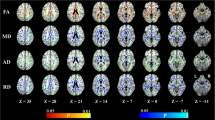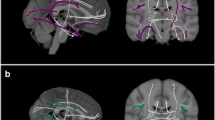Abstract
Purpose
We utilized cerebral blood volume (CBV) magnetic resonance imaging and diffusion tensor imaging (DTI) to investigate changes in cognitive networks in patients experiencing cognitive dysfunction following electrical injury.
Methods
Cognitive function was assessed across various domains, including attention, verbal memory, executive function, and language. Depressive symptoms were also evaluated. CBV maps and DTI measures were obtained from 24 patients (age, 41.8 ± 5.8 years; education, 13.3 ± 1.9 years) and 24 healthy controls (age, 42.3 ± 2.7 years; education, 14.3 ± 1.9 years). CBV maps and DTI measures were compared between patients and controls, and correlations between these measures and each cognitive assessment score were examined.
Results
Patients exhibited lower attention, verbal memory, and executive function scores than controls (all p < 0.01). Patients also exhibited higher depression scores than controls (p < 0.01), as well as a predominant increase in CBV in the cerebellar vermis relative to that of controls (height p < uncorrected 0.001, extent p < corrected 0.05). Correlation analyses revealed a strong association between executive function scores and CBV in the bilateral posterior cingulate cortex and left mammillary body in patients (height p < uncorrected 0.001, extent p < corrected 0.05). There were no significant differences in DTI measures between patients and controls.
Conclusion
The CBV maps showed hypermetabolism in the cerebello-limbic system; DTI did not find any microstructural changes. Our results suggest that patients experiencing cognitive dysfunction following electrical injury may possess a cognitive reserve that protects against deteriorating conditions such as dementia.


Similar content being viewed by others
References
Martin TA, Salvatore NF, Johnstone B (2003) Cognitive decline over time following electrical injury. Brain injury: [BI] 17:817–823
Pliskin NH, Ammar AN, Fink JW, Hill SK, Malina AC, Ramati A, Kelley KM, Lee RC (2006) Neuropsychological changes following electrical injury. Journal of the International Neuropsychological Society: JINS 12:17–23
Wesner ML, Hickie J (2013) Long-term sequelae of electrical injury. Can Fam Physician 59:935–939
Ohn SH, Kim DY, Shin JC, Kim SM, Yoo W-K, Lee S-K, C-h P, Jung K-I, Jang KU, Seo CH (2013) Analysis of high-voltage electrical spinal cord injury using diffusion tensor imaging. J Neurol 260:2876–2883
Lin W, Celik A, Paczynski RP (1999) Regional cerebral blood volume: a comparison of the dynamic imaging and the steady state methods. J Magn Reson Imaging 9:44–52
Small SA, Chawla MK, Buonocore M, Rapp PR, Barnes CA (2004) Imaging correlates of brain function in monkeys and rats isolates a hippocampal subregion differentially vulnerable to aging. Proc Natl Acad Sci U S A 101:7181–7186
Schobel SA, Chaudhury NH, Khan UA, Paniagua B, Styner MA, Asllani I, Inbar BP, Corcoran CM, Lieberman JA, Moore H (2013) Imaging patients with psychosis and a mouse model establishes a spreading pattern of hippocampal dysfunction and implicates glutamate as a driver. Neuron 78:81–93
Small SA, Schobel SA, Buxton RB, Witter MP, Barnes CA (2011) A pathophysiological framework of hippocampal dysfunction in ageing and disease. Nat Rev Neurosci 12:585–601
Ahn H-J, Chin J, Park A, Lee BH, Suh MK, Seo SW, Na DL (2010) Seoul Neuropsychological Screening Battery-Dementia Version (SNSB-D): a useful tool for assessing and monitoring cognitive impairments in dementia patients. J Korean Med Sci 25:1071–1076
Lee JH, Lee KU, Lee DY, Kim KW, Jhoo JH, Kim JH, Lee KH, Kim SY, Han SH, Woo JI (2002) Development of the Korean version of the consortium to establish a registry for Alzheimer's disease assessment packet (CERAD-K) clinical and neuropsychological assessment batteries. J Gerontol Ser B Psychol Sci Soc Sci 57:P47–P53
Kim H, Na DL (1999) Normative data on the Korean version of the Boston Naming Test. J Clin Exp Neuropsychol 21:127–133
Yi JS, Bae SO, Ahn YM, Park DB, Noh KS, Shin HK, Woo HW, Lee HS, Han SI, Kim YS (2005) Validity and reliability of the Korean version of the Hamilton Depression Rating Scale (K-HDRS). Journal of Korean Neuropsychiatric Association 44:456–465
Moreno H, Wu WE, Lee T, Brickman A, Mayeux R, Brown TR, Small SA (2007) Imaging the Aβ-related neurotoxicity of Alzheimer disease. Arch Neurol 64:1467–1477
Friston KJ, Holmes AP, Worsley KJ, Poline JP, Frith CD, Frackowiak RS (1994) Statistical parametric maps in functional imaging: a general linear approach. Hum Brain Mapp 2:189–210
Friston KJ, Worsley KJ, Frackowiak R, Mazziotta JC, Evans AC (1994) Assessing the significance of focal activations using their spatial extent. Hum Brain Mapp 1:210–220
Smith SM, Jenkinson M, Johansen-Berg H, Rueckert D, Nichols TE, Mackay CE, Watkins KE, Ciccarelli O, Cader MZ, Matthews PM (2006) Tract-based spatial statistics: voxelwise analysis of multi-subject diffusion data. NeuroImage 31:1487–1505
Winkler AM, Ridgway GR, Webster MA, Smith SM, Nichols TE (2014) Permutation inference for the general linear model. NeuroImage 92:381–397
Smith SM, Nichols TE (2009) Threshold-free cluster enhancement: addressing problems of smoothing, threshold dependence and localisation in cluster inference. NeuroImage 44:83–98
Gauthier S, Reisberg B, Zaudig M, Petersen RC, Ritchie K, Broich K, Belleville S, Brodaty H, Bennett D, Chertkow H (2006) Mild cognitive impairment. Lancet 367:1262–1270
Dubois B, Albert ML (2004) Amnestic MCI or prodromal Alzheimer's disease? The Lancet Neurology 3:246–248
Andrews CJ (2012) The origin of remote symptoms in electrical and lightning injuries: an attempt at explanation and a hypothesis for testing. Journal of Lightning Research 4:149–154
Ramati A, Pliskin NH, Keedy S, Erwin RJ, Fink JW, Bodnar EN, Lee RC, Cooper MA, Kelley K, Sweeney JA (2009) Alteration in functional brain systems after electrical injury. J Neurotrauma 26:1815–1822
Deveci M, Bozkurt M, Arslan N, Sengezer M (2002) Nuclear imaging of the brain in electrical burn patients. Burns 28:591–594
Şahiner T, Kurt T, Bir LS, Oğuzhanoğlu A, Akalin O, Çeliker A, Özdemir F (2002) Reversible hyperintense T2 MRI lesions of basal ganglia after an electrical injury. Burns 28:607–608
Stoodley CJ, Schmahmann JD (2009) Functional topography in the human cerebellum: a meta-analysis of neuroimaging studies. NeuroImage 44:489–501
Baleydier C, Mauguiere F (1980) The duality of the cingulate gyrus in monkey. Neuroanatomical study and functional hypothesis. Brain J Neurol 103:525–554
Pandya D, Van Hoesen G, Mesulam M-M (1981) Efferent connections of the cingulate gyrus in the rhesus monkey. Exp Brain Res 42:319–330
Amlien I, Fjell A (2014) Diffusion tensor imaging of white matter degeneration in Alzheimer’s disease and mild cognitive impairment. Neuroscience 276:206–215
Chua TC, Wen W, Slavin MJ, Sachdev PS (2008) Diffusion tensor imaging in mild cognitive impairment and Alzheimer's disease: a review. Curr Opin Neurol 21:83–92
Stuss DT, Guberman A, Nelson R, Larochelle S (1988) The neuropsychology of paramedian thalamic infarction. Brain Cogn 8:348–378
Minoshima S, Giordani B, Berent S, Frey KA, Foster NL, Kuhl DE (1997) Metabolic reduction in the posterior cingulate cortex in very early Alzheimer's disease. Ann Neurol 42:85–94
Nestor PJ, Fryer TD, Smielewski P, Hodges JR (2003) Limbic hypometabolism in Alzheimer's disease and mild cognitive impairment. Ann Neurol 54:343–351
Johnson S, Schmitz T, Moritz C, Meyerand M, Rowley H, Alexander A, Hansen K, Gleason C, Carlsson C, Ries M (2006) Activation of brain regions vulnerable to Alzheimer's disease: the effect of mild cognitive impairment. Neurobiol Aging 27:1604–1612
Bierman E, Comijs H, Jonker C, Beekman A (2005) Effects of anxiety versus depression on cognition in later life. Am J Geriatr Psychiatry 13:686–693
Parsons TD, Rizzo AR, Cvd Z, McGee JS, Buckwalter JG (2005) Gender differences and cognition among older adults. Aging Neuropsychol Cognit 12:78–88
Author information
Authors and Affiliations
Corresponding author
Ethics declarations
Funding
This study was funded by the Basic Science Research Program through the National Research Foundation of Korea (NRF) funded by the Ministry of Science, ICT & Future Planning (2014R1A1A1006893) and the Hallym University Research Fund 2014 (HURF-2014-06).
Conflict of interest
The authors declare that they have no conflict of interest.
Ethical approval
All procedures performed in this study involving human participants were approved by the institutional review board of Hallym University Sacred Heart Hospital (IRB No. 2014-I049) and with the 1964 Helsinki declaration and its later amendments or comparable ethical standards.
Informed consent
Informed consent was obtained from all individual participants included in the study.
Rights and permissions
About this article
Cite this article
Park, Ch., Seo, C.H., Jung, M.H. et al. Investigation of cognitive circuits using steady-state cerebral blood volume and diffusion tensor imaging in patients with mild cognitive impairment following electrical injury. Neuroradiology 59, 915–921 (2017). https://doi.org/10.1007/s00234-017-1876-1
Received:
Accepted:
Published:
Issue Date:
DOI: https://doi.org/10.1007/s00234-017-1876-1




